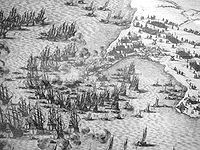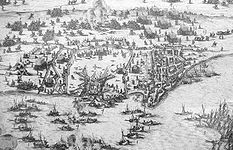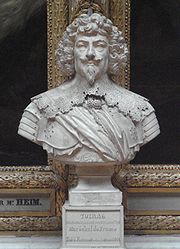.gif)
Siege of Saint-Martin-de-Ré (1627)
Encyclopedia
The Siege of Saint-Martin-de-Ré, also Siege of St. Martin's (French:Siège de Saint-Martin-de-Ré), occurred in the French isle of Ile de Ré
around the fortress of the city of Saint-Martin-de-Ré
, when Duke of Buckingham
tried to occupy the island in 1627. After three months of combats and sieges however, Governor Toiras and a relief force of French ships and troops managed to repel the Duke of Buckingham, who was forced to withdraw in defeat. This encounter followed another defeat for Buckingham, the 1625 Cádiz Expedition
, and is considered as the opening conflict of the Anglo-French War of 1627-1629
, itself a part of the Thirty Years' War
.

 On 12 July 1627, an English
On 12 July 1627, an English
invasion force of 100 ships and 6,000 soldiers under the command of the Duke of Buckingham invaded the island of Ile de Ré
at the beach of Sablanceau
with the objective of controlling the approaches to La Rochelle, and of encouraging the rebellion in the city. Buckingham wished to capture the Fort of La Prée and the fortified city of Saint Martin de Ré. Toiras fought against the landing from behind the dunes, with a force of 1,200 infantry and 200 horsemen, but the English beachhead was maintained, with over 12 officers and 100 men dead.
During a period of three days during which Buckingham consolidated his beachhead, Toiras took all the available provisions on the island and fortified himself in the citadel of Saint Martin with 1,000 men. Buckingham endeavoured to establish a siege around the citadel, but things proved difficult.
The English siege engineer had drowned during the landing, the cannons were too few and too small, and disease started to take its toll on the English troops as Autumn arrived. The siege continued until October.
 Requested supplies from England also proved insufficient. Irish troops numbering 2,000 arrived under Sir Ralph Bingley on 3 September 1627. A small supply fleet under Sir William Beecher arrived with only 400 raw troops.
Requested supplies from England also proved insufficient. Irish troops numbering 2,000 arrived under Sir Ralph Bingley on 3 September 1627. A small supply fleet under Sir William Beecher arrived with only 400 raw troops.
A Scottish fleet composed of 30 ships, with 5,000 men, was on its way on October 1627, but was broken up by a storm on the coast of Norfolk
.
A strong relief fleet under the Earl of Holland
only departed on 6 November 1627, which proved to be too late.
The French on their side, despite difficulties, managed to run a supply fleet during the night of 7–8 October 1627, with 29 ships managing to make it through the English naval blockade on a total of 35. From the mainland, 4,000 additional troops were landed on the southern end of the island on October 20. The rescue troops were under the Marshal of France
Henri de Schomberg
.


 Buckingham attempted a last desperate attack on Saint Martin on October 27, but it was a failure. The Saint Martin fortress again proved to be impregnable, and the English ladders turned out to be too short to scale the fortification walls.
Buckingham attempted a last desperate attack on Saint Martin on October 27, but it was a failure. The Saint Martin fortress again proved to be impregnable, and the English ladders turned out to be too short to scale the fortification walls.
Although there are indications that the Saint Martin French garrison was also close to exhaustion, Buckingham finally retreated with his troops towards the northern part of the island, with the objective of embarking at the area of Loix
. He was harassed by pursuing French troops, with heavy casualties. Altogether, Buckingham lost more than 5,000 men in the campaign, out of a force of 7,000.
 Two months into the siege of Saint-Martin-de-Ré, the people of La Rochelle finally started open hostilities against the central government of France in September, initiating the Siege of La Rochelle
Two months into the siege of Saint-Martin-de-Ré, the people of La Rochelle finally started open hostilities against the central government of France in September, initiating the Siege of La Rochelle
.
Following the defeat of Buckingham in October, England attempted to send two fleets to relieve La Rochelle. The first one, led by William Feilding
, Earl of Denbigh, left on April 1628, but returned without a fight to Portsmouth
, as Denbigh "said that he had no commission to hazard the king's ship in a fight and returned shamefully to Portsmouth".
Back in England, Buckingham tried to organize a second campaign to relieve the Siege of La Rochelle, but he was stabbed and killed at Portsmouth on August 23, 1628 by John Felton, an army officer who had been wounded in the earlier military adventure and believed he had been passed over for promotion by Buckingham. Felton was hanged in November and Buckingham was buried in Westminster Abbey
. The second fleet was finally dispatched under the Admiral of the Fleet, the Earl of Lindsey
in August 1628, but remained blocked by the seawall
in front of La Rochelle.
Exhausted and without hope of outside support anymore, La Rochelle finally surrendered to French Royal forces on 28 October 1628. Following these defeats, England would end its involvement with the Thirty Years War, by negotiating peace treaties, with France in 1629 and Spain in 1630, to the dismay of Protestant forces on the continent.
Following these conflicts, the main port of Saint Martin, was further fortified by Vauban
in 1681.
Île de Ré
Île de Ré is an island off the west coast of France near La Rochelle, on the northern side of the Pertuis d'Antioche strait....
around the fortress of the city of Saint-Martin-de-Ré
Saint-Martin-de-Ré
Saint-Martin-de-Ré is a commune in the Charente-Maritime department in southwestern France.It is one of the 10 communes located on the Île de Ré.-History:Saint-Martin-de-Ré has extensive fortifications, reflecting the strategic importance of the Île de Ré...
, when Duke of Buckingham
George Villiers, 1st Duke of Buckingham
George Villiers, 1st Duke of Buckingham KG was the favourite, claimed by some to be the lover, of King James I of England. Despite a very patchy political and military record, he remained at the height of royal favour for the first two years of the reign of Charles I, until he was assassinated...
tried to occupy the island in 1627. After three months of combats and sieges however, Governor Toiras and a relief force of French ships and troops managed to repel the Duke of Buckingham, who was forced to withdraw in defeat. This encounter followed another defeat for Buckingham, the 1625 Cádiz Expedition
Cádiz Expedition (1625)
The Cádiz Expedition of 1625 was a naval expedition against Spain by English and Dutch forces.The plan was put forward because after the Dissolution of the Parliament of 1625, the Duke of Buckingham, Lord High Admiral wanted to undertake an expedition that would match the exploits of the heroes of...
, and is considered as the opening conflict of the Anglo-French War of 1627-1629
Anglo-French War (1627-1629)
The Anglo-French war of 1627-1629 was part of the Thirty Years' War. It mainly involved actions at sea. The centre of the conflict surrounded the Siege of La Rochelle, in which the English crown supported the French Huguenots in their fight against the French royal forces of Louis XIII of France in...
, itself a part of the Thirty Years' War
Thirty Years' War
The Thirty Years' War was fought primarily in what is now Germany, and at various points involved most countries in Europe. It was one of the most destructive conflicts in European history....
.
Landing


England
England is a country that is part of the United Kingdom. It shares land borders with Scotland to the north and Wales to the west; the Irish Sea is to the north west, the Celtic Sea to the south west, with the North Sea to the east and the English Channel to the south separating it from continental...
invasion force of 100 ships and 6,000 soldiers under the command of the Duke of Buckingham invaded the island of Ile de Ré
Île de Ré
Île de Ré is an island off the west coast of France near La Rochelle, on the northern side of the Pertuis d'Antioche strait....
at the beach of Sablanceau
Sablanceau
Sablanceau is a beach at the easternmost end of the island of Ile de Ré in western France. Sablanceau belongs to the commune of Rivedoux-Plage.-English landing :...
with the objective of controlling the approaches to La Rochelle, and of encouraging the rebellion in the city. Buckingham wished to capture the Fort of La Prée and the fortified city of Saint Martin de Ré. Toiras fought against the landing from behind the dunes, with a force of 1,200 infantry and 200 horsemen, but the English beachhead was maintained, with over 12 officers and 100 men dead.
During a period of three days during which Buckingham consolidated his beachhead, Toiras took all the available provisions on the island and fortified himself in the citadel of Saint Martin with 1,000 men. Buckingham endeavoured to establish a siege around the citadel, but things proved difficult.
The English siege engineer had drowned during the landing, the cannons were too few and too small, and disease started to take its toll on the English troops as Autumn arrived. The siege continued until October.
Reinforcements

A Scottish fleet composed of 30 ships, with 5,000 men, was on its way on October 1627, but was broken up by a storm on the coast of Norfolk
Norfolk
Norfolk is a low-lying county in the East of England. It has borders with Lincolnshire to the west, Cambridgeshire to the west and southwest and Suffolk to the south. Its northern and eastern boundaries are the North Sea coast and to the north-west the county is bordered by The Wash. The county...
.
A strong relief fleet under the Earl of Holland
Earl of Holland
Earl of Holland was a title in the Peerage of England. It was created in 1624 for Henry Rich, 1st Baron Kensington. He was the younger son of Robert Rich, 1st Earl of Warwick. and had already been created Baron Kensington in 1623, also in the Peerage of England. His eldest son, the second Earl,...
only departed on 6 November 1627, which proved to be too late.
The French on their side, despite difficulties, managed to run a supply fleet during the night of 7–8 October 1627, with 29 ships managing to make it through the English naval blockade on a total of 35. From the mainland, 4,000 additional troops were landed on the southern end of the island on October 20. The rescue troops were under the Marshal of France
Marshal of France
The Marshal of France is a military distinction in contemporary France, not a military rank. It is granted to generals for exceptional achievements...
Henri de Schomberg
Henri de Schomberg
Henri de Schomberg , comte de Nanteuil, was a Marshal of France during the reign of Louis XIII.Schomberg was born at Paris. Superintendent of Finances from 1619 to 1622. He became Marshal of France in 1625....
.
Final assault and retreat



Although there are indications that the Saint Martin French garrison was also close to exhaustion, Buckingham finally retreated with his troops towards the northern part of the island, with the objective of embarking at the area of Loix
Loix
Loix is a commune in the Charente-Maritime department in southwestern France. It is situated on the Île de Ré.-Population:-References:*...
. He was harassed by pursuing French troops, with heavy casualties. Altogether, Buckingham lost more than 5,000 men in the campaign, out of a force of 7,000.
Aftermath

Siege of La Rochelle
The Siege of La Rochelle was a result of a war between the French royal forces of Louis XIII of France and the Huguenots of La Rochelle in 1627-1628...
.
Following the defeat of Buckingham in October, England attempted to send two fleets to relieve La Rochelle. The first one, led by William Feilding
William Feilding, 1st Earl of Denbigh
William Feilding, 1st Earl of Denbigh was an English naval officer and courtier.William Feilding was the son of Basil Fielding of Newnham Paddox in Warwickshire, , and of Elizabeth, daughter of Sir Walter Aston and his wife, Elizabeth Leveson.The descent of the Feildings from the house of Habsburg,...
, Earl of Denbigh, left on April 1628, but returned without a fight to Portsmouth
Portsmouth
Portsmouth is the second largest city in the ceremonial county of Hampshire on the south coast of England. Portsmouth is notable for being the United Kingdom's only island city; it is located mainly on Portsea Island...
, as Denbigh "said that he had no commission to hazard the king's ship in a fight and returned shamefully to Portsmouth".
Back in England, Buckingham tried to organize a second campaign to relieve the Siege of La Rochelle, but he was stabbed and killed at Portsmouth on August 23, 1628 by John Felton, an army officer who had been wounded in the earlier military adventure and believed he had been passed over for promotion by Buckingham. Felton was hanged in November and Buckingham was buried in Westminster Abbey
Westminster Abbey
The Collegiate Church of St Peter at Westminster, popularly known as Westminster Abbey, is a large, mainly Gothic church, in the City of Westminster, London, United Kingdom, located just to the west of the Palace of Westminster. It is the traditional place of coronation and burial site for English,...
. The second fleet was finally dispatched under the Admiral of the Fleet, the Earl of Lindsey
Robert Bertie, 1st Earl of Lindsey
Robert Bertie, 1st Earl of Lindsey was an English peer, soldier and courtier.-Early life:...
in August 1628, but remained blocked by the seawall
Seawall
A seawall is a form of coastal defence constructed where the sea, and associated coastal processes, impact directly upon the landforms of the coast. The purpose of a seawall is to protect areas of human habitation, conservation and leisure activities from the action of tides and waves...
in front of La Rochelle.
Exhausted and without hope of outside support anymore, La Rochelle finally surrendered to French Royal forces on 28 October 1628. Following these defeats, England would end its involvement with the Thirty Years War, by negotiating peace treaties, with France in 1629 and Spain in 1630, to the dismay of Protestant forces on the continent.
Following these conflicts, the main port of Saint Martin, was further fortified by Vauban
Vauban
Sébastien Le Prestre, Seigneur de Vauban and later Marquis de Vauban , commonly referred to as Vauban, was a Marshal of France and the foremost military engineer of his age, famed for his skill in both designing fortifications and breaking through them...
in 1681.

